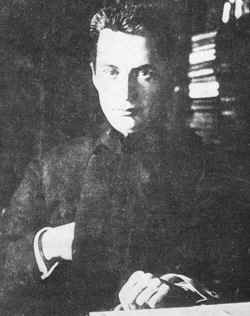Alexander Kerensky led, for part of its short life, the Provisional Government. Kerensky belonged to the Socialist Revolutionaries, the Petrograd Soviet and was a member of the Duma. He was therefore seen as a solid representative of the working class and in July 1917 became the Prime Minister of the Provisional Government.
 |
Kerensky was born in 1881 in Simbirsk. Like so many of the people associated with the Russian Revolution, he had a comfortable upbringing. His father was a head teacher and one of the star young pupils at his school was Vladimir Ulyanov – later to be better known as Lenin. Kerensky studied law at St Petersburg University. At this moment in history, university students were considered to be a radical body, probably because they could see the ills in Russia’s society – and they certainly could not defend them. From 1912 to 1917, Kerensky was a member of the Duma where he stood as a democratic socialist.
He was also voted in as the deputy chairman of the Petrograd Soviet, therefore, despite his middle class background, Kerensky did develop a positive relationship with the working class of St Petersburg.
After the abdication of Nicholas II in March 1917, Kerensky was made Minister of Justice in the Provisional Government. In May, he was promoted to Minister of War and in July he became Prime Minister. His rise to power was swift but Kerensky had developed a reputation for effective leadership in whatever area of government he worked in.
However, as Prime Minister he made two major errors. He ensured that Russia stayed in a war that was detested in the country itself. The overwhelming bulk of the population wanted Russia to withdraw from the war. There must have been few families, especially among the poor, who had not experienced personal tragedy between 1914 and 1917. His second mistake was not to offer the peasants land. Lenin did just this and immediately got the support he and the Bolsheviks needed at the expense of Kerensky.
To undermine the support of the Bolsheviks, Kerensky ordered that elections should take place for a constituent assembly. The elections were to be held in January 1918. Lenin had called for such elections earlier in 1917, so he could not object to this. As Kerensky argued, it was simply an extension of the democratic process denied to the people by the Romanovs. However, all the evidence indicated that the Bolsheviks would have done less well than other groups – including the Mensheviks.
Spurred into action by the near certainty of defeat in the January elections, Lenin ordered a coup d’état on November 7th, 1917. Brilliantly successful, the November Revolution ended the Provisional Government and the power of Kerensky. He fled to France, moved to Australia and then spent 24 years living in America.
Alexander Kerensky died in 1970.
Related Posts
- The Provisional Government The Provisional Government came into being on March 14th 1917. Based in the capital, Petrograd, the Provisional Government was first led by…
- The Provisional Government is the name given to the government that led Russia from March 1917 to November 1917. Throughout its existence, the Provisional Government…